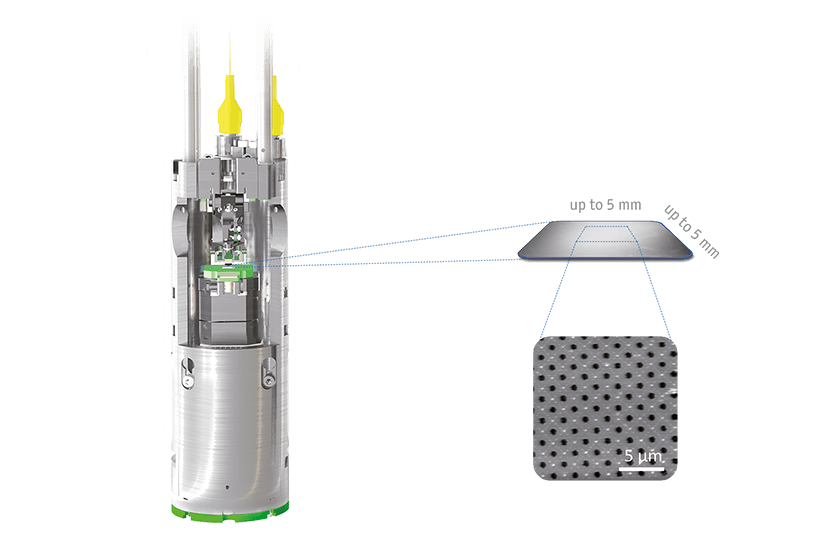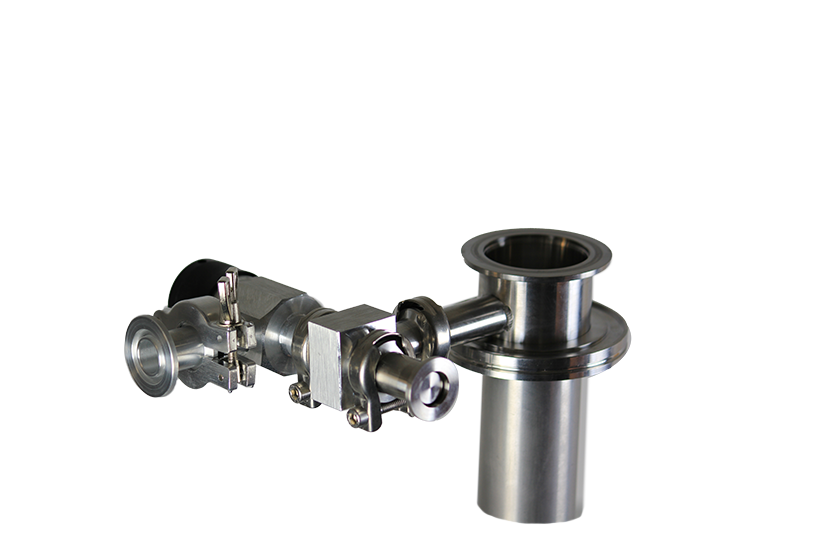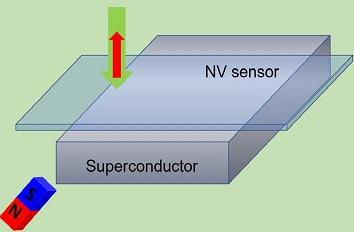attoAFM/CFM
combined atomic force and confocal microscope
unique combination of AFM and CFM
platform for NV based nanomagnetometry (ODMR)
independent xyz-positioning of AFM tip and sample
precisely position NV centers in focus & scan sample
closed loop scanning (optional)
easy retrieval of regions-of-interest

The attoAFM/CFM is a combined atomic force and confocal microscope designed for use at variable temperature down to mK, and in high magnetic fields. Featuring an apochromatic, cryogenic objective with high numerical aperture and low working distance for high collection efficiency over a wide wavelength range, the challenge to integrate an AFM tip in between the extremely tight space between objective and sample was solved by using a socalled inverted Akiyama probe AFM tip. This special self-sensing and self-actuating AFM sensor is based on a microcantilever attached to a tuning fork, which turns the horizontal oscillation of its prongs into a vertical oscillation of the cantilever.
The most typical application of this microscopy platform is its use for optically detected magnetic resonance (ODMR) using nitrogenvacancy color centers (NV centers) as highly sensitive and ultrasmall sensors. This atomic-sized spin system which shows spin dependent photoluminescence, and can be used as a well-controlled single photon source. Its exceptionally long spin coherence times translate into extremely high magnetic sensitivities beyond the nT range. In order to employ the outstanding properties of NV centers for magnetic imaging, the combination of an AFM (which controls the position of the sensor with respect to the sample surface), and a confocal microscope (which provides the optical spin state preparation and readout in reflection mode) is used. Local magnetic fields can subsequently be measured via the Zeeman shifts of the NV defect spin sublevels which are directly proportional to the local magnetic fields encountered by the tip.
This condition can be detected by a decrease in photoluminescence intensity of the NV center under resonant microwave excitation, referred to as ODMR.
The attoAFM/CFM is available with an optional interferometric encoder for closed loop scanning. The microscope uses two sets of xyz-positioners for coarse positioning, and hence allows for independent positioning of the sample and AFM tip over a range of several mm. Typically, the AFM sensor hosting the NV center as sensor is positioned exactly into the focal spot of the high NA objective, and then the sample is scanned underneath both sensors. The additional piezo-based xyz scanner for both tip and sample each provide a large scan range even at cryogenic temperatures; usually however, only one set of xyz scanners is used during most experiments.
Last but not least, due to the open signal architecture of our powerful and flexible ASC500 SPM controller, the needs of experts are addressed to have control over all signals, while maintaining a very user-friendly software interface that also supports measurement routines based on LabVIEW scripts. All in- and output signals are accessible via front panel BNCs, and can hence easily be monitored, stored and used for additional control loops or spectroscopies. Finally, our unique closed loop scan option allows for global sample navigation over the complete range of the microscope at cryogenic temperatures, and hence enables the retrieval of regions of interest very precisely. For more info please refer to the fundamentals section.

Specifications
| General Specifications | |
|---|---|
| type of instrument | combined confocal (CFM) and atomic force microscope (AFM) |
| sensor head specifics | AFM: Akiyama probe (quartz tuning fork combined with a mircomachined cantilever); CFM: attoCFM I external optics head and low temperature apochromatic objective |
| Modes of Operation | |
| imaging modes | optically detected magnetic resonance (ODMR), AFM, CFM |
| slope compensation | 2 axis scan plane correction |
| z feedback | AFM: PI feedback loop for amplitude modulation (AM), phase modulation (PM) or frequency modulation (FM) using included PLL |
| Resolution | |
| z bit resolution @ 4 K | 7.6 pm at 2 µm scan range |
| Confocal Unit | |
| configuration | compact and modular design, two or more optical channels; standard configuration: one excitation and one detection channel |
| key benefits | quick and reliable alignment of each channel, steering mirror for combined beams long-term stability |
| quick-exchange of optical components | beamsplitters, filter mounts for up to 4 filters/polarizers, (1" diameter); optional piezoelectric rotator with filter mount |
| pinhole configuration | two pinholes (fiber apertures), different illumination and collection wavelength possible |
| pinhole size | dependent on fibers, typically 3 .. 9 µm mode field diameter |
| compatible LT-objective | LT-APO/VIS, LT-APO/VISIR, LT-APO/NIR (see accessory section for more information) |
| inspection unit | sample imaging with large field of view: ~54 µm (attoDRY) |
| Illumination | |
| excitation wavelength range | 400 .. 1000 nm, default 650 nm (others on request) |
| illumination port specification | FC/ APC-connector for single mode fibers or free-beam configuration |
| Detection | |
| detection mode | e.g. optically detected magnetic resonance (ODMR), luminescence, fluorescence |
| detection wavelength range | detector upon user`s choice, typically Si detector (coupling of the light to other detectors) |
| detection port specification | FC/ APC-connector for single mode fibers or free-beam configuration |
| Sample Positioning | |
| total travel range | independent degrees of freedom for tip and sample of 2 mm x 3 mm x 2.5 mm (closed loop) |
| step size | 0.05..3 µm @ 300 K, 10..500 nm @ 4 K |
| fine scan range | 30 x 30 x 4.3 µm³ @ 300 K, 12 x 12 x 2 µm³ @ 4 K (open loop) |
| closed loop scanning | optional |
| sample holder | Ti plate with integrated heater and calibrated temperature sensor |
| Suitable Operating Conditions | |
| temperature range | 1.5 K..300 K (dependent on cryostat); mK compatible setup available on request |
| magnetic field range | 0..15 T+ (dependent on magnet) |
| operating pressure | designed for He exchange gas (vacuum compatible version down to 1E-6 mbar on request) |
| Suitable Cooling Systems | |
| titanium housing diameter | 48 mm |
| bore size requirement | designed for a 2" (50.8 mm) cryostat/magnet bore |
| compatible cryostats | attoDRY1000/1100/2100 |
| Compatibility with Electronics | |
| scan controller and software | ASC500 (for detailed specifications please see attoCONTROL section) |
| Options and Upgrades | |
| closed loop scanning & global sample coordinates | interferometric encoders for scan linearization and closed loop sample navigation |
| in-situ inspection optics | resolution approx. 20 µm (depending on cryostat, distance top-flange to field center) |
| closed loop upgrade for coarse positioners | resistive encoder, range 3 mm, sensor resolution approx. 200 nm, repeatability 1-2 µm |
Features
Accessories
Suitable Cryostats
Fields of Applications
Customer Feedback
Dr. Vincent Jacques
LPQM, ENS-Cachan, France
Owing to the high stability and easy operation of the attoAFM/CFM, we were able to perform first magnetometry experiments within only a few months. Support from attocube engineers was always very prompt and efficient. The system is now operated since two years and I must say that it has been the cornerstone of the rapid development of scanning probe magnetometry in our group.
Prof. Dr. Patrick Maletinsky
Department of Physics, University of Basel, Switzerland
Our attoLIQUID1000-based attoAFM/CFM system was a complete game-changer for starting up my research group. Instead of spending years developing a highly complex technical system on our own, we had a fully operational, high-performance cryogenic AFM/CFM system at hand within a relatively short timespan. This allowed us to plunge into our scientific endeavours with highest efficiency. As always, this attocube product stands out due to it’s reliability, ease of use and excellent performance. A particular further asset is the systems versatility - interfacing it with our existing experiments was straight-forward due to the clever system design and excellent support from attocube’s application engineers.






















